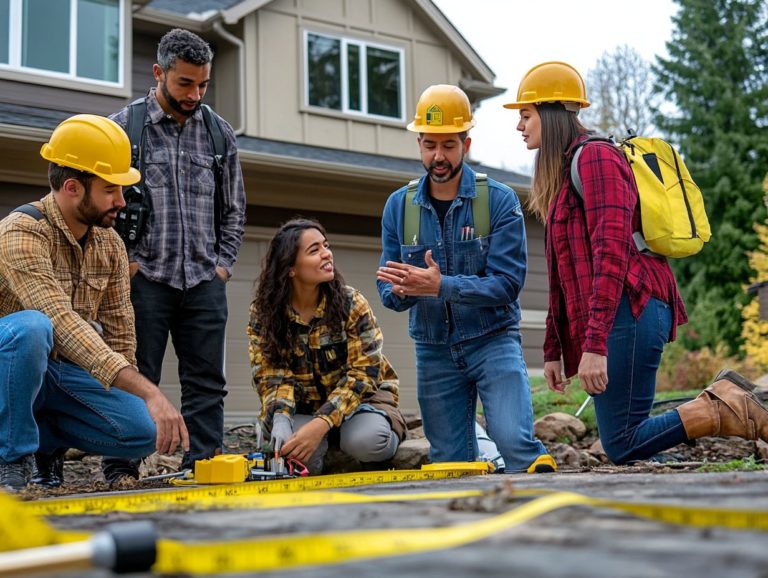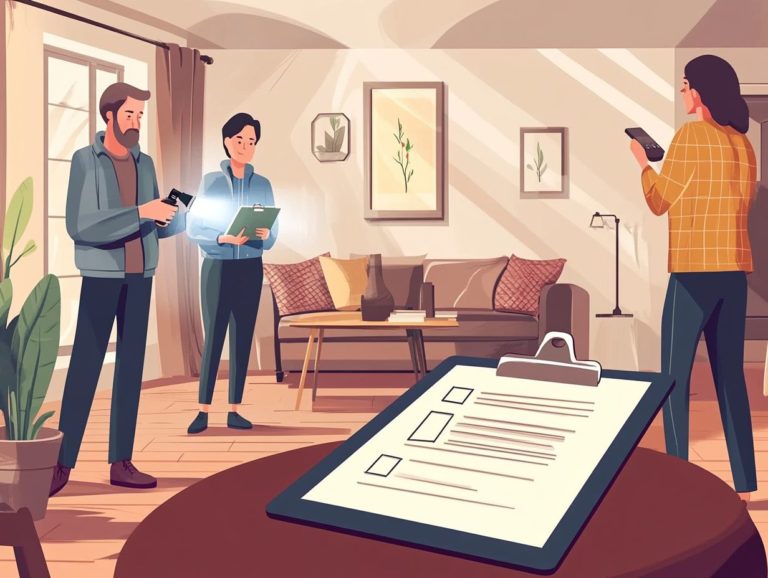DIY Home Inspection: A Step-by-Step Guide
Homeownership brings with it a host of responsibilities, and one of the most vital is ensuring that your sanctuary remains safe and sound.
Engaging in DIY home inspections empowers you to take control of your living environment. You can spot potential issues before they snowball into significant problems.
This guide will lead you through each step of the process, from gathering essential tools and mastering the inspection checklist to thoroughly evaluating both the exterior and interior of your home.
You ll discover how to identify hazards and implement actionable steps to maintain a secure space. Whether you re a seasoned homeowner or embarking on your journey as a first-time buyer, this guide equips you for a successful DIY inspection.
Contents
- Key Takeaways:
- Preparing for a Home Inspection
- Exterior Inspection
- Interior Inspection
- Identifying Potential Hazards
- Final Steps and Recommendations
- Frequently Asked Questions
- What is a DIY home inspection?
- Why should I perform a DIY home inspection?
- What are the key steps to conducting a DIY home inspection?
- Do I need any special tools or equipment for a DIY home inspection?
- How long does a DIY home inspection typically take?
- What should I do if I find major issues during my DIY home inspection?
Key Takeaways:

Don’t wait! Save money and ensure your home s quality by conducting your own inspection today!
Be prepared by gathering necessary tools and understanding the inspection checklist before starting the process.
Conduct a thorough inspection of both the exterior and interior of your home while identifying potential hazards and taking appropriate action.
Why DIY Home Inspections are Important
Conducting a DIY home inspection is essential for you, whether you’re buying or selling a home. It gives you the opportunity to pinpoint potential problems before they escalate into costly issues, making understanding the home inspection process crucial.
This proactive approach boosts your home’s value. It also provides crucial insights into its condition, helping smoother repair negotiations and informed maintenance decisions.
Taking the initiative to inspect your home can lead to significant savings. You can spare yourself those pricey professional fees while gaining knowledge about critical systems like plumbing and HVAC (Heating, Ventilation, and Air Conditioning).
Being well-informed enables you to tackle issues head-on, allowing you to present a well-maintained property to prospective buyers. This can enhance your appeal and even increase offers.
Understanding the mechanics of your home fosters a sense of control and confidence, making the entire buying or selling process more efficient and far less daunting.
Preparing for a Home Inspection
Proper preparation for a home inspection is essential for you, whether you’re a buyer or a seller. This preparation lays the groundwork for a comprehensive evaluation of the property’s condition.
By taking the time to prepare, you can facilitate a thorough inspection process that benefits everyone involved.
Gathering Necessary Tools and Materials
Gathering the right tools and materials is crucial for conducting a successful home inspection. This enables you to effectively identify plumbing problems, electrical system issues, and HVAC concerns. For a comprehensive approach, refer to the essential checklist for home inspections.
Equipping yourself with specific instruments like moisture meters, voltage testers, and high-powered flashlights can significantly elevate your inspection process.
A moisture meter is invaluable for detecting hidden water damage or potential mold growth, which can pose serious health risks if neglected. Meanwhile, voltage testers are essential for ensuring that your electrical systems are safe and compliant with standards.
A powerful flashlight is essential for illuminating dark corners like basements and crawl spaces. This enables a more thorough examination of critical components.
Each of these tools plays a vital role in assessing current issues and prioritizing preventive measures for future home maintenance.
Understanding the Home Inspection Checklist
A well-structured home inspection checklist is an invaluable asset. It guides you through the inspection process with precision while ensuring that critical areas like safety checks, plumbing, and HVAC systems receive thorough evaluation.
This systematic approach saves you time and helps you uncover potential issues that might not be readily visible.
By breaking down the inspection into various components such as structural integrity, roofing, electrical systems, and specific property features like basements or crawl spaces you can customize the checklist to address your unique concerns.
Incorporating common repairs that often arise during inspections, such as faulty wiring or plumbing leaks, further enhances its efficacy. Ultimately, this checklist becomes both a preventive measure and a powerful tool for making informed decisions.
Exterior Inspection

The exterior inspection is a pivotal part of the home inspection process. It focuses on essential factors such as roofing issues, foundation cracks, and the overall condition of outdoor spaces.
These aspects can significantly impact both the property’s value and safety. Therefore, this assessment is essential for informed decision making.
Assessing the Roof, Siding, and Foundation
During an exterior inspection, checking the roof, siding, and foundation is crucial as these components are vital to the building’s structural strength. They can also reveal signs of decay or potential water damage.
For the roof, scrutinize the condition of the shingles. Ensure none are cracked or missing, as these issues can lead to leaks. Check the gutters for buildup or improper alignment to prevent water pooling that could compromise the foundation.
While examining the siding, look for gaps, warping, or discoloration, which can indicate moisture intrusion or pest damage. When assessing the foundation, check for cracks, settling issues, or signs of dampness that could signal serious structural concerns.
By carefully evaluating these elements, you’ll gain a clearer understanding of the property’s overall health.
Interior Inspection
The interior inspection focuses on essential systems within your home, including plumbing, electrical, and heating, ventilation, and air conditioning (HVAC) systems.
A thorough check will keep your home safe and running smoothly, protecting you from potential hazards and avoiding costly repairs down the line.
Checking Electrical, Plumbing, and HVAC Systems
<pWhen conducting an interior inspection, it s critical to check the electrical system, plumbing, and HVAC systems. These core components play a crucial role in the safety and livability of your home.
A comprehensive evaluation of these systems guarantees functionality and helps you spot potential red flags that could lead to expensive repairs if ignored.
For the electrical system, watch for:
- Frayed wires
- Outdated panels
- Signs of corrosion that may indicate a need for upgrades
For plumbing, be vigilant for common issues such as:
- Leaking pipes
- Low water pressure
- The condition of fixtures, which can reveal wear and tear over time
When checking HVAC systems, it s important to look for:
- Unusual noises
- Inadequate heating or cooling
- Dirty filters, all of which can impact efficiency
By prioritizing safety checks like examining smoke detectors and carbon monoxide alarms you further enhance the overall condition of your home.
Identifying Potential Hazards
Identifying potential hazards during a home inspection is crucial for safeguarding the safety and well-being of future occupants. Issues like water seepage, mold problems, and other safety concerns can profoundly impact the home’s overall condition.
Don’t wait address these issues now to protect your home!
By being diligent in this process, you not only protect your investment but also ensure a secure environment for those who will call it home.
Identifying and Addressing Safety Concerns

Identifying and addressing safety concerns during the inspection process is essential for safeguarding the health of the occupants and maintaining the home’s integrity. It also equips you with answers to common repairs and maintenance questions.
This process goes beyond simple observations; it s vital for documenting potential hazards comprehensively. When inspectors highlight these safety concerns, they provide actionable steps for remediation that can significantly reduce risks.
By offering guidance on resolving issues like faulty wiring or water leaks, you gain the knowledge needed to take informed actions that enhance your safety and protect your property s value. This thorough documentation serves as a valuable reference for future inspections or repairs, promoting a proactive approach to home maintenance that can save you time and money down the line.
Final Steps and Recommendations
The final steps after a home inspection involve compiling an inspection report and offering well-informed recommendations for repairs. Understand how these findings can impact the home’s value and future negotiation discussions regarding repairs.
After your inspection, compile your findings and plan your next steps wisely. This will help maintain your home’s value and safety.
Completing the Inspection and Taking Action
Completar la inspecci n y tomar decisiones basadas en tus hallazgos es esencial para compradores y vendedores. Esto asegura una transacci n exitosa y mejora la condici n del hogar.
Una vez que tengas el informe de inspecci n, revisa los problemas identificados. Comunica cualquier solicitud de reparaciones o concesiones al vendedor para fomentar una buena voluntad.
Planificar las reparaciones necesarias es importante. Aborda primero las preocupaciones que pueden afectar el valor o la seguridad de la propiedad.
Si encuentras complicaciones, considera una evaluaci n adicional. Inspecciones de plagas o evaluaciones estructurales pueden ofrecer m s claridad sobre el estado del hogar.
Al seguir estos pasos, aumentas tu confianza en tu inversi n. Los vendedores tambi n pueden mostrar su compromiso con el mantenimiento de la propiedad.
Frequently Asked Questions
What is a DIY home inspection?
A DIY home inspection is a thorough evaluation of a property that is conducted by the homeowner themselves, without the assistance of a professional inspector. It involves inspecting different aspects of a home, such as the structure, plumbing, and electrical systems, and understanding the basics of home inspections can be incredibly helpful during this process.
Why should I perform a DIY home inspection?

A DIY home inspection allows you to have a better understanding of your home’s condition. It can help identify potential issues and, by navigating the home inspection process, save you money by avoiding costly repairs later on.
What are the key steps to conducting a DIY home inspection?
The key steps to conducting a DIY home inspection include creating a checklist, thoroughly inspecting the interior and exterior of the home, and documenting any issues. For detailed guidance, consider reading about how to prepare for a home inspection and seek professional assistance if needed.
Do I need any special tools or equipment for a DIY home inspection?
While not necessary, having a few basic tools such as a flashlight, screwdriver, and ladder can be helpful. These tools assist in inspecting areas that may be difficult to access.
How long does a DIY home inspection typically take?
The duration of a DIY home inspection can vary depending on the size and condition of the home. On average, it can take anywhere from 2 to 4 hours to complete a thorough inspection, especially if you have a home inspection prep checklist to guide you.
What should I do if I find major issues during my DIY home inspection?
If you find major issues during your DIY home inspection, it is important to seek professional assistance. A licensed home inspector or contractor can provide a thorough evaluation and help you understand the home inspection process to determine the best course of action for addressing any problems.






